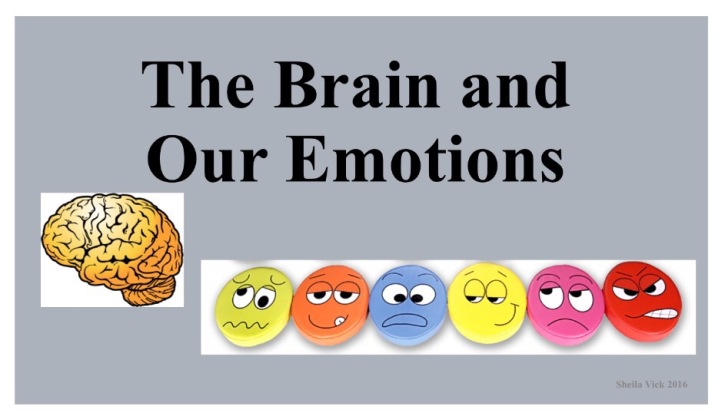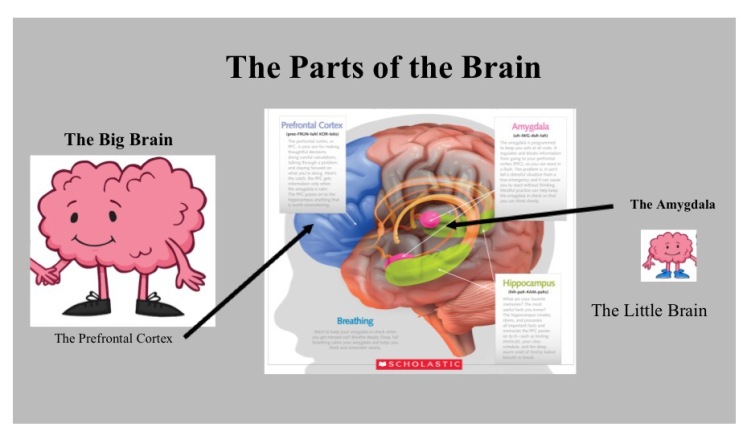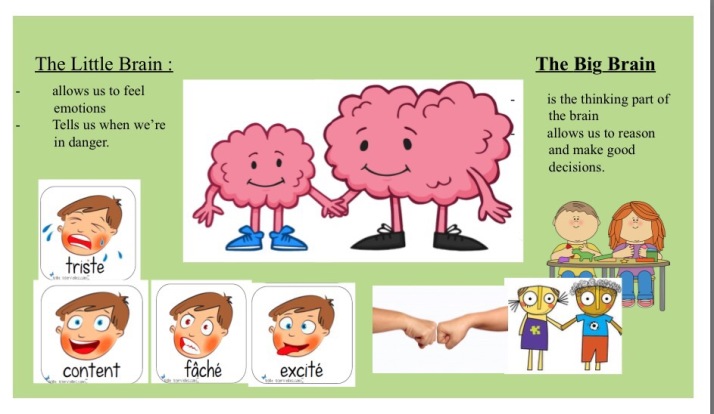Social Emotional Learning & Empathy #IMMOOC
In chapter 1 of The Innovator’s Mindset, innovation is defined as a way of thinking that creates something new and better. As educators, we are constantly having to reflect upon our practices to make sure that we are always doing what’s best for our learners. Simply doing something because “it’s always been done this way” isn’t acceptable anymore. This year, I’ve put a lot of focus on social emotional learning in my classroom and I believe that it has helped immensely in shaping empathetic students. Empathy is the 1st characteristic of the Innovator’s Mindset and is obviously a very important quality to have, however teaching this quality isn’t always easy. Thankfully, my wonderful friend and colleague, Sheila Vick is always by my side helping me to create rich, authentic learning experiences for my students that also make them better people all around.
One of my all time favorite lessons is the one of Big Brain and Little Brain. Sheila and I first introduced this to my students last year and it was a huge success, so we knew we had to do it again this year. Here in the lesson, taken from Sheila’s blog (please click here to view her full blog post):
The beginning of the lesson always started out with finding out what the kids already knew about the brain. Given their age, most of what they shared related to thinking and being smart.
Following this sharing session, I informed them that the brain is made up of several parts, but that we would only be learning about two of them on this particular day. Here is where, depending on the age, more detail could be added.
During the lesson, I presented to the students the amygdala and the prefrontal cortex, which I said, to simplify things, we would call the little brain and the big brain respectively. This was the modified version Robbie G. had shared with me. If you read Siegel’s book, you will see that he sometimes calls these areas the downstairs brain (little brain) and the upstairs brain (big brain). The little ones seemed to relate more to the little brain, big brain terminology, so I stuck with it.
Next, with the support of my student helpers, I explained in simple terms, the functions of each of these parts (see above slide), mainly that the little brain (amygdala) lets us know when we are in danger and allows us to feel big emotions, and that the big brain (prefrontal cortex) allows us to think things through properly and make good decisions.
Then came the fun part, showing the kids the hand brain model. As shown in Siegel’s explanation (watch here), I had them put their hand up with their thumb tucked in, and had them imagine their thumb as their little brain (amygdala). I reminded them that this part of the brain lets them know when they are in danger and lets them feel big emotions, and that it is an important part of the brain, but that it also needs the big brain (prefrontal cortex) to make smart decisions. Here, I had them curl their fingers down to show them the big brain (as pictured in the slide below). I showed that the big brain was touching the little brain, allowing them to work together to make good decisions, but that if they flipped their lid, they would no longer be touching and they would be unable to make good decisions (prefrontal cortex disengages from the amygdala).
Showing the kids the hand brain model seemed to be their favourite part of the lesson and has come in very handy (pardon the pun) ever since. They loved the visual of their brain and it has really helped them to understand the two parts and that they have to be touching (both engaged) to be working properly (making good decisions). They now understand that when they have flipped their lid and are in their little brain (amygdala), that they are not able to think clearly and make good decisions. This doesn’t mean that lids aren’t being flipped, but in the heat of a peer conflict, for example, they are better able to understand when the teacher says it would be best to take a bit of time to calm down (get in their big brains) before trying to resolve the conflict. The teachers regularly refer to this hand visual to ask students where they’re at (in their big or little brain) and what they need to do to stay or get in their big brain. They practice different calming strategies with students throughout the day to show them different ways of getting from their little brain to their big brain, continually adding to the students’ toolboxes of calming strategies.
You can also check out the following two videos that we use in our lessons. This one is of students and Sheila’s daughter sharing what they’ve learned about the brain and this one is of kids talking about the brain and their emotions. These are fantastic resources for students because they get to hear it from kids!
Again this year, this lesson has been a huge success. We are continuously referring back to big brain and little brain and how being self aware can help diffuse many situations. We took some time to read Sometimes I”m Bombaloo by Rachel Vail which really helped  students to see how someone might act when they are in their little brain, and how everyone flips their lid! Now that the students have a good understanding of how their brain and their emotions work, we are working on strategies to help students get back into their big brains. We started this lesson by checking out one of Sheila’s blog posts that she co-wrote with her 5 year old daughter, Elsie. In this post, Elsie shares her favorite calm down strategies when she flips her lid. The students responded very well to her ideas as we practiced them together. We are now in the process of reading and looking more closely at the book Frog’s Breathtaking Speech by
students to see how someone might act when they are in their little brain, and how everyone flips their lid! Now that the students have a good understanding of how their brain and their emotions work, we are working on strategies to help students get back into their big brains. We started this lesson by checking out one of Sheila’s blog posts that she co-wrote with her 5 year old daughter, Elsie. In this post, Elsie shares her favorite calm down strategies when she flips her lid. The students responded very well to her ideas as we practiced them together. We are now in the process of reading and looking more closely at the book Frog’s Breathtaking Speech by Michael Chissick and Sarah Peacock. We will continue to explore many different strategies that work to calm us down (which is a very personal thing) and we will be creating a book of our own favorite strategies.
Michael Chissick and Sarah Peacock. We will continue to explore many different strategies that work to calm us down (which is a very personal thing) and we will be creating a book of our own favorite strategies.
Finally, I just wanted to share a parent’s perspective on the lessons surrounding the Big Brain and Little brain lessons, because I think it speaks volume. I’ve seen first hand that these lessons have a great positive impact on my students, but it’s also very encouraging when I hear the positive feedback from the students’ parents. Here is part of an e-mail that I got from a parent, after our lesson:
[Y]esterday as we left school he got upset. I immediately mentally prepared for the outburst cycle that is all too familiar and mentally geared up to stay calm in the face of a very angry and withdrawn 6 year old. As he was angrily walking away from me I asked him if I could help him feel better. His reply was that this can’t be fixed. He continued to storm off but I heard him muttering “this is my Little Brain in control. I can’t fix this.” So I asked again, and changed my phrasing “Can I help you calm your Little Brain down?” at this point he stopped and he listened. Within minutes, and with no yelling and minimal tears, the situation was resolved and we were on our way home.
And then this is where it gets really good! On our way home he said that he had something he wanted to tell me. He explained how he felt he had had a “Little Brain sort of day” and how there had been an incident at school with another child – they had fought and he had pushed the other child. He proactively informed me of the situation: what started it, what happened, the results, who he talked to, how he managed it and how he felt about it now. I could see that he understood where he had done wrong, and that he had taken responsibility for not only his actions but also for his reactions. He explained how his teacher had helped him talk it out and how she had allowed him to make decisions about how to calm himself down. He also explained how after taking a break from interacting with the other child, it made him feel really good to reconnect with that child later. For us to see him not only taking responsibility for his actions, but to clearly communicate them in a proactive way without misplaced fear of negative consequence, and then to show pride in his ability to manage what had been two separate upsetting situations was nothing short of remarkable.
Throughout this incident, he used the language from this lesson plan. He has clearly taken it in and is using it actively to help regulate, understand and communicate his emotions. As parents, my husband and I are thrilled that the lesson was shared with us as it has helped us to meet him on his level when negative moments occur.
Phew, this was a long post! I think that empathy and learning to understand our emotions is a huge part of 21st century learning and plays a big part in being able to embrace the innovator’s mindset. Our students will be better off understanding their feelings and how to deal with them, but also being able to understand what their classmates are feelings and how they can best help them. It really is amazing how my students have responded to these lessons and how they are using this new knowledge to figure things out on their own.





Calm Down Strategies – Innovation in 1st grade
March 10, 2017 at 3:47 pm[…] my last post Social Emotional Learning & Empathy, I talked about the power of the Big Brain and Little Brain lesson. I also mentioned […]
Laurie Storm
March 10, 2017 at 5:15 pmThank you for sharing this! For a student to acknowledge he is having a “little brain sort of day” is more perceptive than I am on some days. This is a great PBL idea for K-2 (all grades honestly, but K-2 in my school anyway is always looking for something that tackles social/emotional and PBL). Having the students share this with other grades/parents/community would be awesome. Maybe “reading buddies” can be expanded to “breathing buddies” or “calming buddies” to work on mindfulness or understand big brain/little brain days.
Thanks again!
Annick Rauch
March 10, 2017 at 5:29 pmGreat idea incorporating PBL in this!! Love the breathing buddies, that would be awesome!!!!
Kara Guiff
March 11, 2017 at 1:35 pmI am so glad I found this blog post! I work with junior high students who are so reactive because they let that little brain control 80% of who they are. I love this big brain/little brain way of explaining it – even to junior high students. I can’t wait to be able to implement this in my social and emotional learning groups!
Annick Rauch
March 11, 2017 at 1:43 pmAwesome Kara!! Let me know how it goes!! 🙂
Brain Train | I.D.E.A.S. in elementary
May 17, 2017 at 12:48 am[…] post on teaching kids about the brain and self-regulation, followed by Annick Rauch’s post on how she followed up these lessons with different breathing strategies, I found it necessary […]